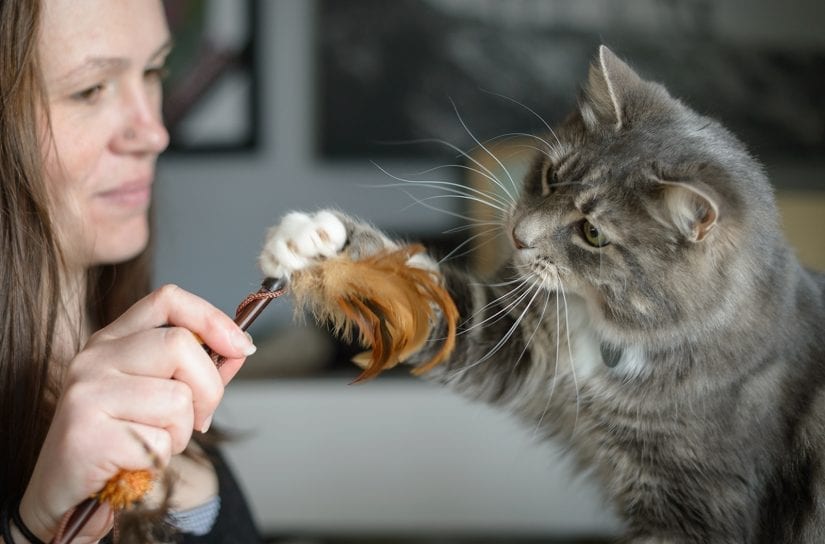Pet care & behaviour
Cats are wonderful companions. Each has a unique personality – just like people!
Some are shy and quiet while others are outgoing and social; but no matter the personality of your cat, they always rely on you as a guardian to provide a good home with what they need to be happy. Remember, a healthy cat is a happy cat!
Typical life span for a cat
- 13 – 20 years
How to keep your cat happy and healthy
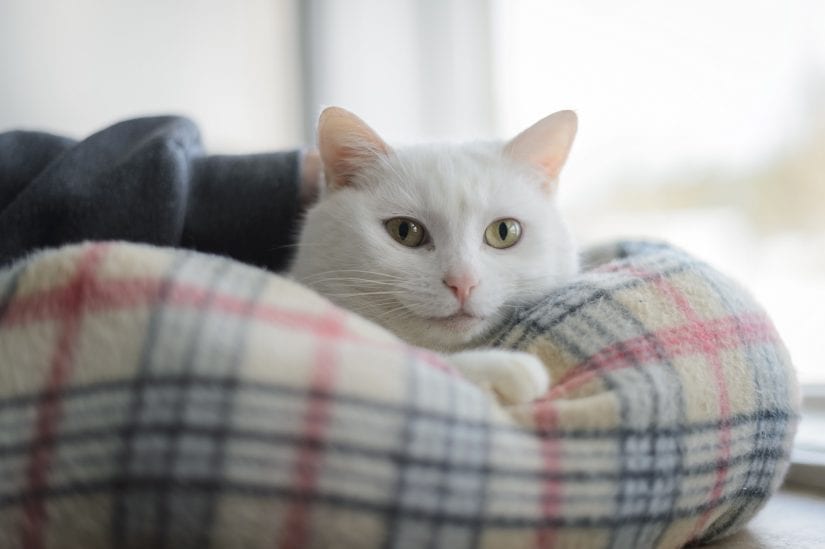
Cat food and feeding
Kittens need good quality kitten food when they’re weaned. Adult cats do best on a mixture of good quality dry kibble and canned food. Feeding guidelines provided on the bag can help you determine how much your kitten or cat should eat in a day.
It is common for most cats to eat two to three meals a day. Feed the last meal of the day right before bedtime. An adult cat will sleep throughout the night. Kittens may need more meals a day.
Some cats need special diets. Ask your vet for a recommendation for your cat.
Your cat must have access to fresh water all the time. Change the water daily and wash out the bowl regularly.
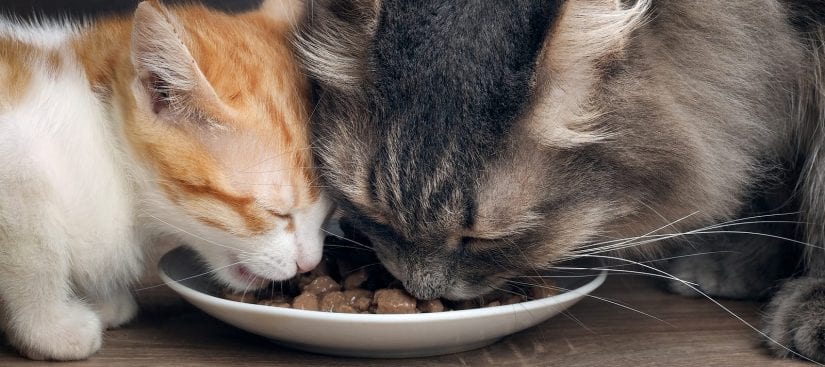
Cat grooming, teeth and nail trimming
Choose a pet service business that prioritizes your cat’s welfare. Learn what to ask so you can confidently choose the right pet care provider.
Grooming
Brush your cat on a regular basis, especially if they are long-haired. Regular brushing prevents hair from matting and removes loose hair. It also will help with hairballs.
Teeth
To keep your cat’s teeth healthy and tartar free, they need to be brushed daily. Buy a special toothpaste and finger brush from your local pet supply store or at your vet clinic. Do not use human toothpaste.
Nails
Nails need regular trimming, usually once a month or as needed. Take care not to cut the blood vessel (the quick) that runs through each nail. Cats who go outside do not need their nails trimmed. They need their nails to climb and defend themselves. If you prefer not to cut your own cat’s nails, a veterinarian can do this for you for a small fee.
Declawing cats
The practice of declawing cats is banned in B.C., unless it is necessary as an appropriate medical therapy. It is also banned in Australia, New Zealand, Israel, Brazil, the United Kingdom, parts of Europe and some cities in California.
Cats’ nails are not like fingernails — they’re attached to the bone. Declawing is a serious surgery. It’s like removing a part of your finger at the knuckle.
Read the BC SPCA Position Statement on Cosmetic and Other Non-Therapeutic Alterations (PDF).
*If your cat is scratching furniture, learn what to do.
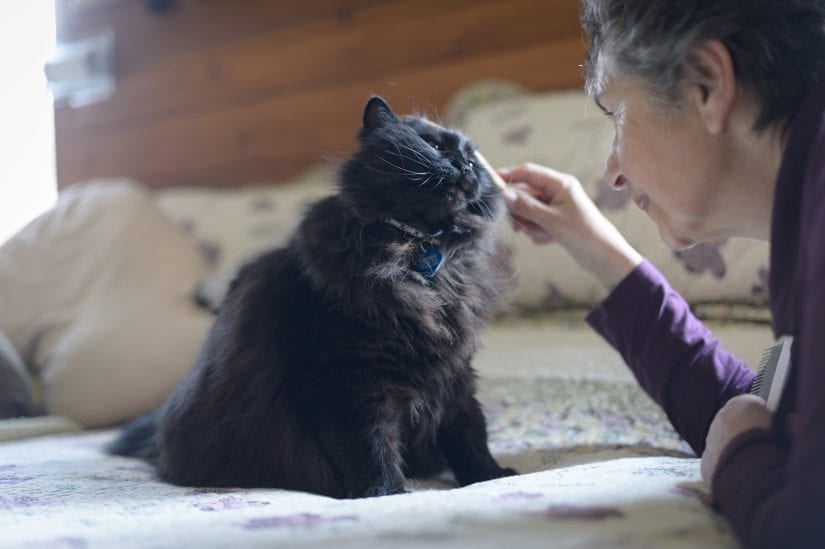
Identification (ID) for your cat
Nobody plans to lose a pet. Prepare for the unexpected and ensure your cat has two forms of identification.
Indoor cats vs outdoor cats
The BC SPCA recommends that cats be indoors, however, some cats get frustrated indoors and may enjoy outdoor time. Whether you choose to let your cat out or keep them in, know how to provide them with the best environment to keep them happy and safe.
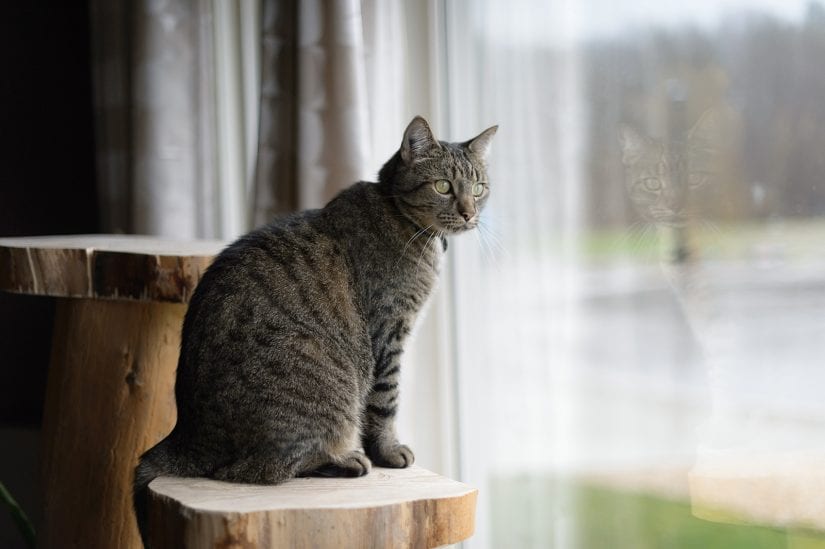
Medical care is important for your cat
Take your cat to see a vet when you first get your cat. After the initial visit with the vet, you may only need to go back once a year for a check-up and vaccinations. Kittens will need to go back more often at first for vaccines.
It is also important to have your pet spayed or neutered to prevent unwanted litters. There are also many behavioural and health benefits to sterilization. Learn more about the benefits of spaying or neutering your pet.
Over time, watch for lumps and bumps on your pet. Also pay attention to signs of your cat not eating or a change in their behaviour. If you notice anything different talk to your vet.
Find a veterinarian in your area.
Learn how to make your kitten or cat’s vet visit less stressful.
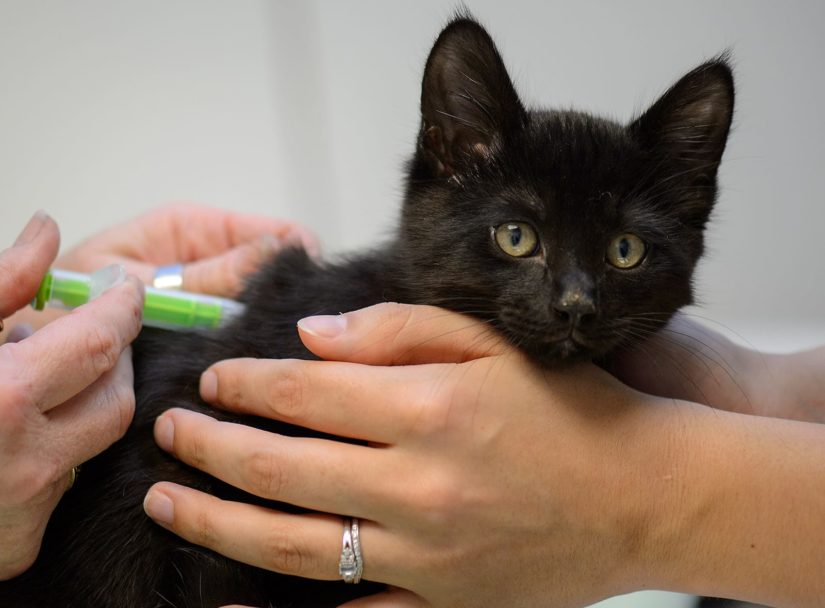
Playtime is a special time with your cat
Cats love to play, explore, run around, use a scratching post and spend time with you. These are all essential activities for cats. Set up your home so your cat can explore, run and scratch on a scratching post.
Make time in your day to play with your cat with a variety of toys, rather than your hands. Learn what to do if your cat or kitten is biting and scratching your hands.
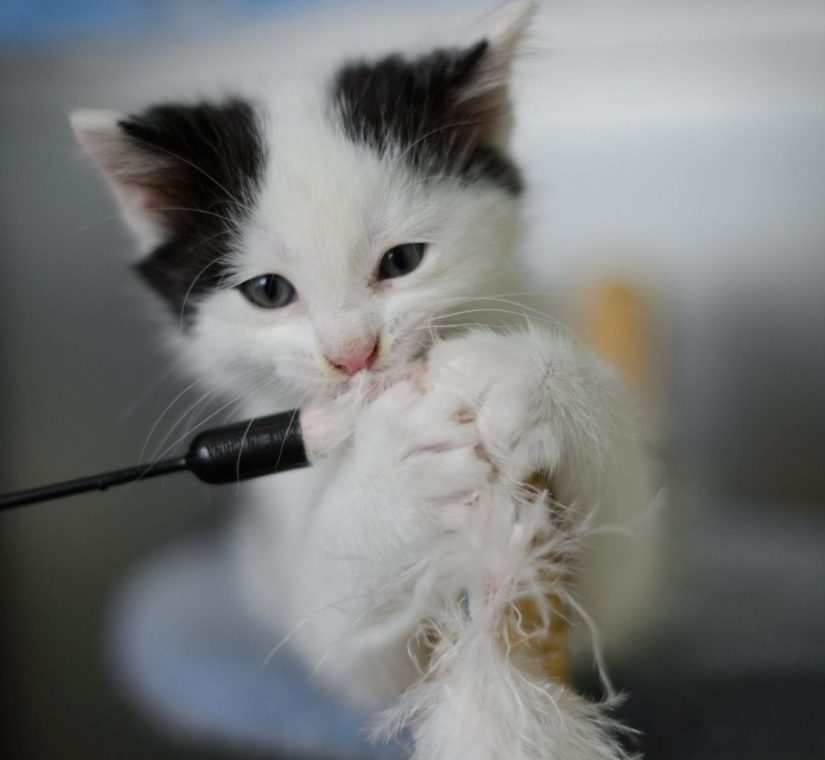
Further resources for cat care and behaviour issues:
Welcoming a new cat into your home
Introducing your new cat to your resident cat
Yes! In fact, Petsecure Pet Health Insurance provides a complimentary six-week trial of pet health insurance with every dog and cat adoption.
With pet health insurance, you can lower the stress of paying for large, unexpected or unplanned expenses with a monthly premium.

If you have cats in your community who appear to be living on their own outdoors, there are a few things you can do to help, especially during the winter months.
Get the cat spayed or neutered: The best method of getting feral cat populations under control is through trap-neuter-return (TNR). This involves trapping the cats, getting them spayed or neutered and vaccinated, and then returning them back to their environment. In addition to humanely reducing the population, TNR also improves the health of the cats and makes them better neighbours.
Contact your local SPCA or cat rescue for advice on how to humanely and safely trap a feral cat. They may even have a trap loan or TNR program to assist you. Community programs are available to help spay and neuter cats to help fight the cat overpopulation problem in B.C.
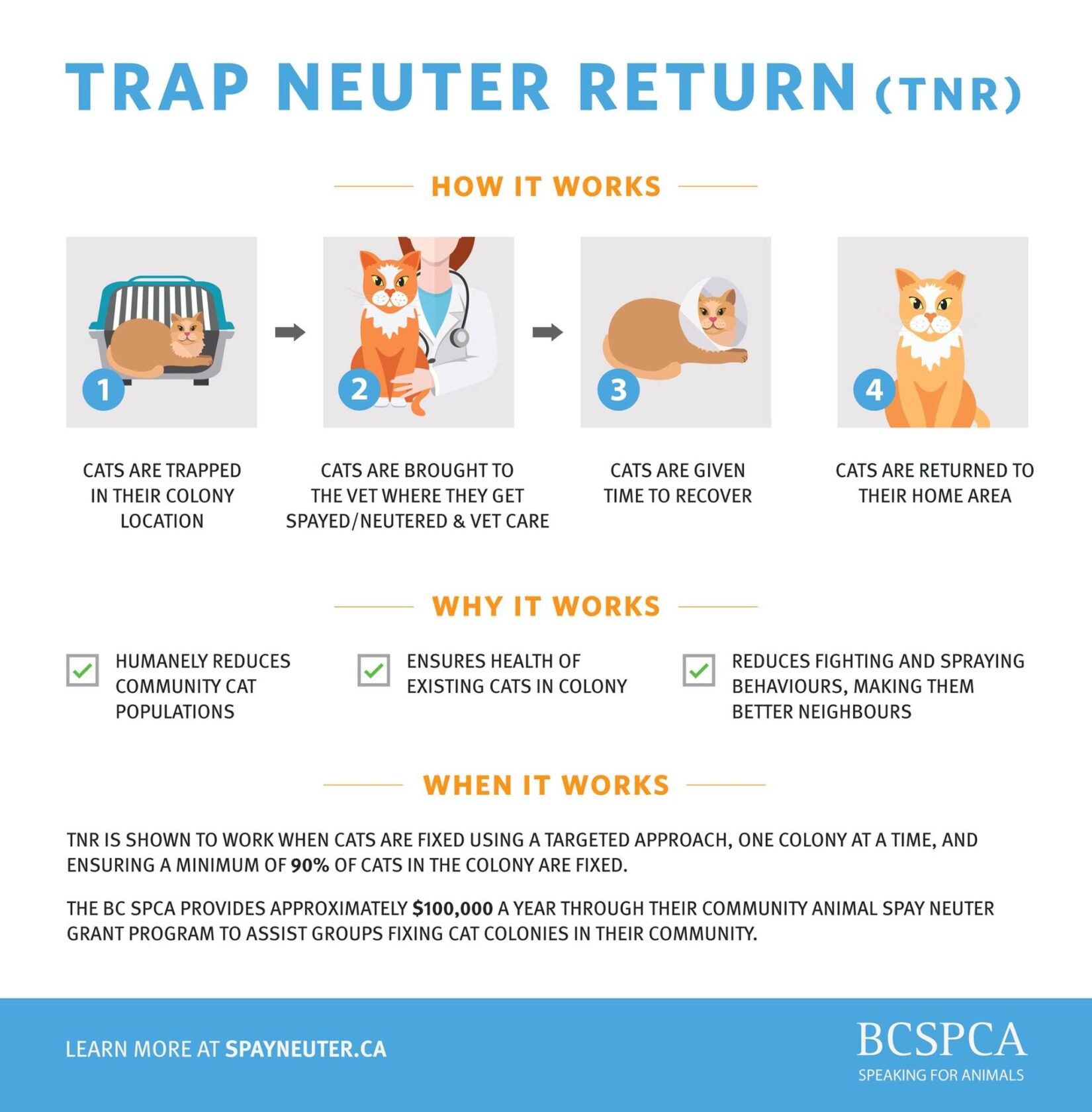
Ensure access to food and water: Food should be left out for cats only during feeding time and then removed to ensure it doesn’t attract wildlife such as raccoons, skunks or bears.
Water should be available at all times. In winter, water sources and wet food can easily freeze over. When you put out water for cats, check it twice daily to make sure it stays ice-free. During the winter, choose dry kibble and ceramic or plastic dishes.
Check your local bylaws: There may be provisions in your municipal bylaw that require you to register the cat colony, or ensure that all cats have permanent identification such as a tattoo or microchip.
Build an outdoor cat shelter: Wintertime is especially hazardous for feral cats. They can struggle through the coldest months of the year to find enough food, water and shelter. Their ears and toes can easily get frostbitten if they don’t have access to a winter shelter.
By providing a cat shelter, cats will be able to escape the wind, snow and rain and make it safely through the cold winter months. Our instructional video walks you through it step by step.
Tap your car: Keep in mind that in the winter months, outdoor cats (and wildlife) may see your car as a warm refuge. Before starting your vehicle, ‘think and thump’ – tap the hood and check between the tires to make sure no cats are hiding underneath or camping out in the engine compartment.
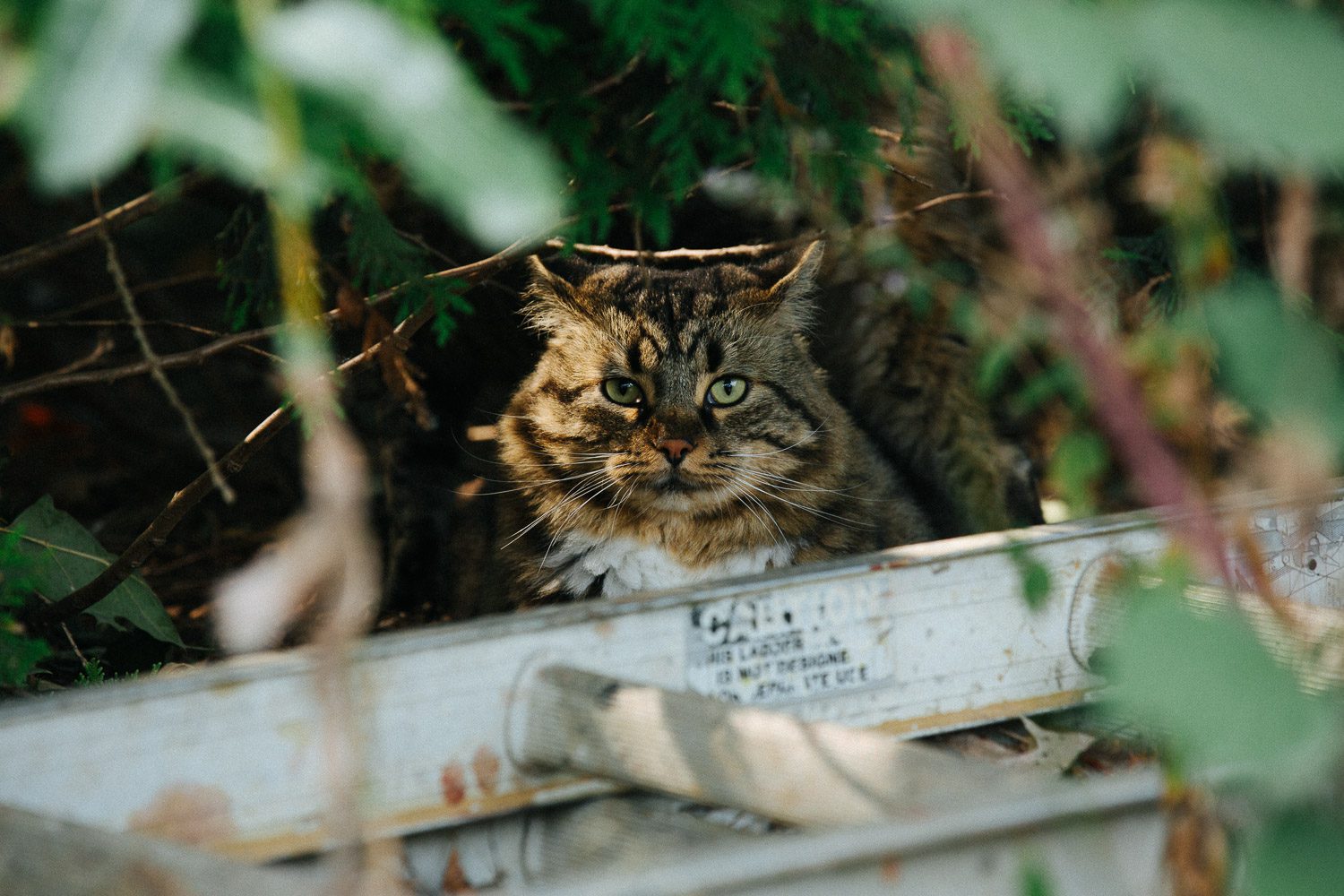
Spay or neuter your own pet: Female cats have a quick reproductive cycle, and cat populations can boom in a very short amount of time. The first step is always to ensure your own pets are spayed and neutered. In addition, we recommend keeping your cat indoors – not only for their own safety, but also to prevent them from catching and spreading diseases or getting lost and ending up part of a feral colony. We have a lot of great tips for how to keep your indoor cat happy and healthy.
Learn more about
“Spaying” and “neutering” are surgical procedures used to prevent pets from reproducing. In a female animal, “spaying” consists of removing the ovaries or uterus and ovaries. The technical term is ovariectomy or ovariohysterectomy. For a male animal, “neutering” involves the removal of the testicles, and this is known as castration.
In addition to preventing unwanted offspring, spaying or neutering has many health and behavioural benefits to the animal.

If you are adopting your cat, dog or rabbit from the BC SPCA, spay/neuter is included in the adoption fee.
For other animals, the cost of spaying or neutering your pet depends on many factors and will vary according to each pet’s circumstances and needs. For example, a large dog will cost more than a small dog. If your pet is overweight or in heat this can also add to the cost. Contact your veterinarian to get a more accurate idea of the costs involved for your pet.
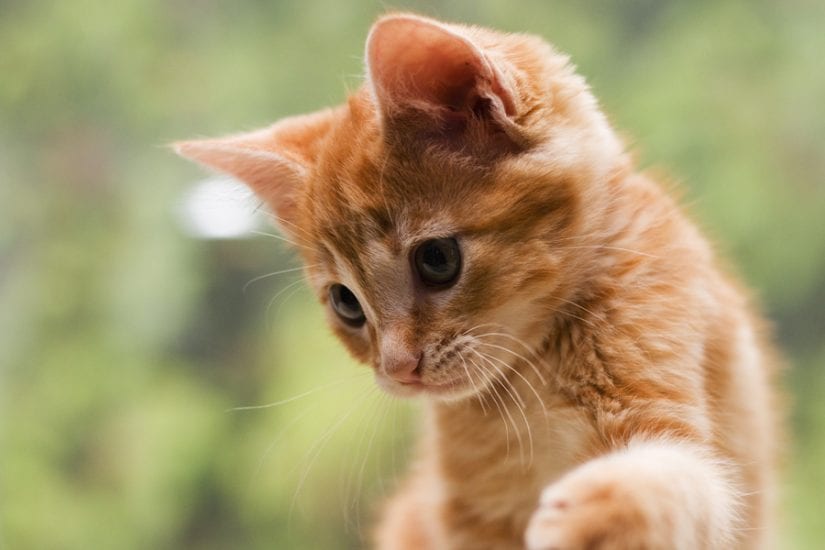
The cost of spaying/neutering is small when compared to other costs of pet care, such as what you will spend on food for your pet over their lifetime.
Consider the possible costs if you do not spay or neuter. If your pet should wander off in search of a mate, you may be faced with paying fines and impoundment fees. You may also be faced with the additional costs of caring for puppies or kittens for whom finding homes may be difficult. Worse yet, think of the costs should your pet be injured while roaming for a mate.
Spaying or neutering is a one-time investment with life-long health and welfare benefits for your companion.
If you require financial assistance, learn about low-cost spay/neuter programs in B.C.
Vaccines protect your pet from getting diseases that are contagious and possibly fatal. Vaccinating your pet doesn’t just protect your pet, it also protects other pets in the community who may be too young or sick to be vaccinated. Vaccines also protect against some diseases that can be passed from pets to people.
All cats and dogs should receive vaccines. Your veterinarian can help determine which vaccines are necessary and the best schedule for vaccinating based on your pet’s lifestyle and age.
Talk to your veterinarian about vaccines for your pet.

Puppies and kittens should start their vaccines at six to eight weeks of age. Your puppy or kitten will need a series of vaccines before they are four months old. Schedules for adult animals may vary depending on lifestyle and vaccines needed.
Rescue animals may require more frequent vaccines while they are in the care of an animal centre due to a high risk of exposure to disease.
Talk to your veterinarian about when to vaccinate your animal.
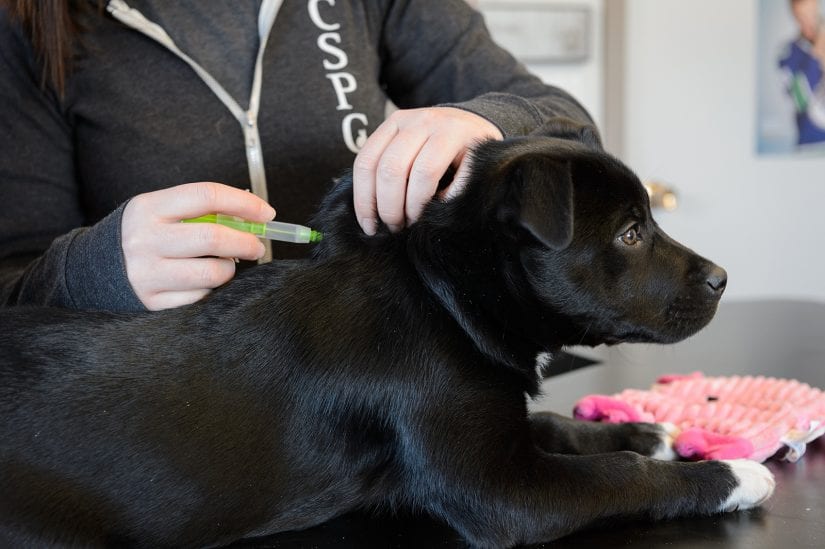
The BC SPCA recommends that cats live indoors. Indoor cats have a longer life span than those that go outside. Whether you choose to let your cat out or keep them in, know how to provide them with the best environment to keep them happy and safe.
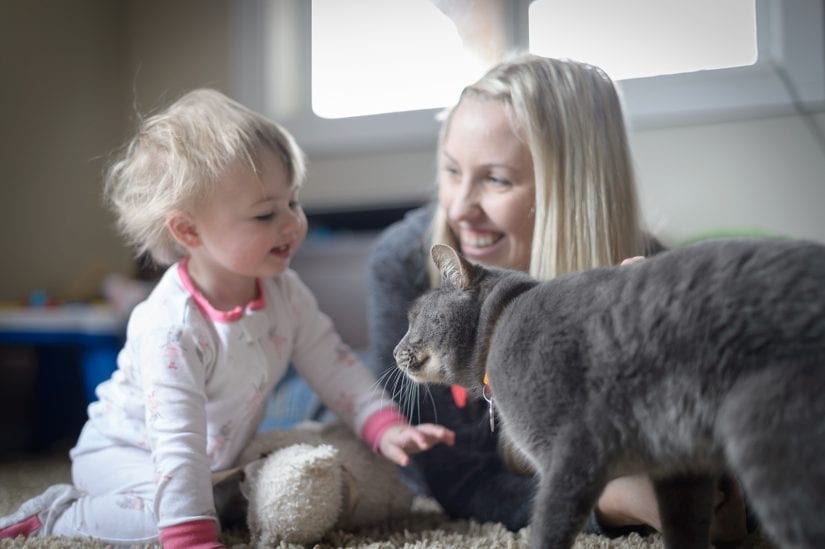
What’s the issue with indoor and outdoor cats?
Risks of letting your cat outdoors
- Other cats or dogs in the neighbourhood can cause injuries to your pet
- Busy streets and traffic can cause injury or death
- Exposure to contagious diseases and parasites
- Extreme weather issues
- Poisoning
- Pet theft
- Animal cruelty
- Eaten or injured by wildlife like coyotes, eagles or other predators
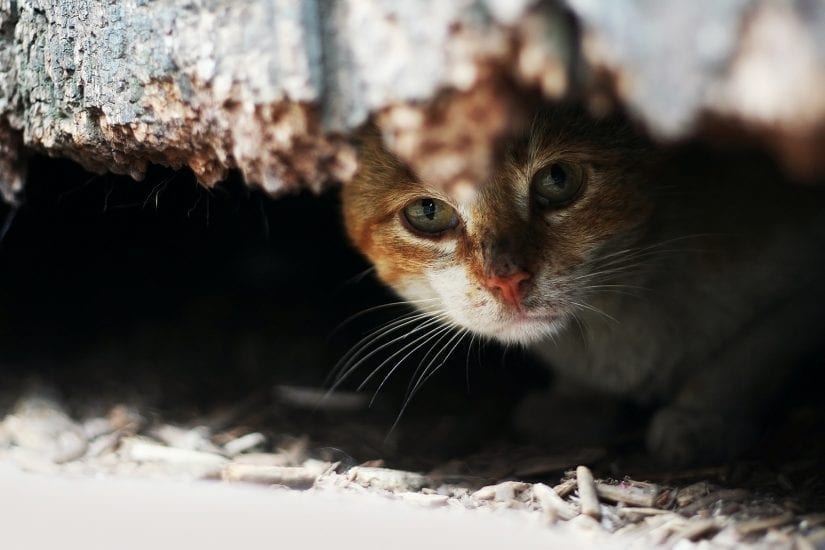
Outdoor roaming cats also cause
- Problems by digging in neighbour’s gardens
- Marking territory by spraying
- Prey on songbirds and other wildlife
Risks for indoor cats
- Depression
- Frustration
- Become lethargic if their environment does not provide enough stimulation
To prevent these issues, help your cat be a cat. Indoor cats need to do things in their home that let them hide, chase, climb, jump and pounce.
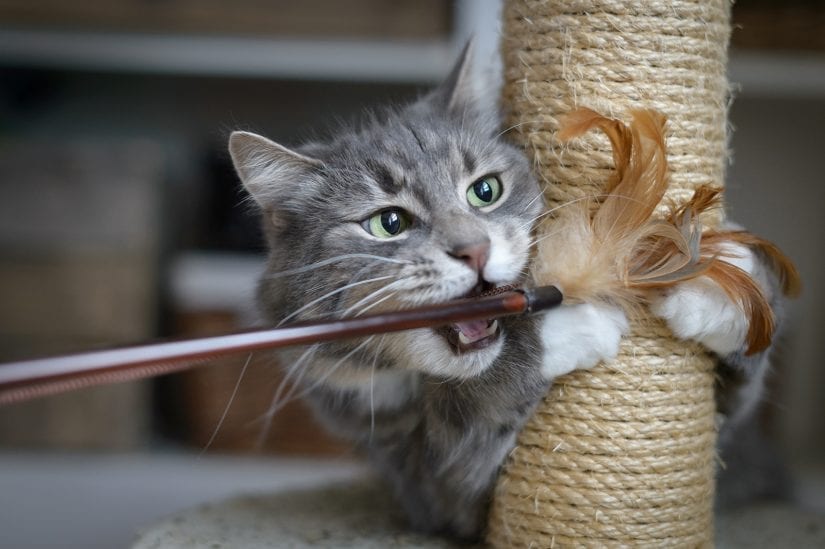
Tips to keep your cat happy, healthy and safe indoors
- Give your cat toys that are safe and stimulating.
- Use feathery and fake furry toys that move like small prey or toys filled with catnip.
- Rotate toys and new objects to ensure there’s always something novel
- Give your cat a scratching post with high perches. Put it near doorways or window.
- Spend time every day interacting with your cat. What does your cat like? Play or petting? Play with toys, games of chase and peek-a-boo. Train your cat.
- Cats need at least 15 to 30 minutes of play broken into short five minute sessions throughout the day.
- Plant a pot of indoor greens for your cat to munch on such as cat grass from seeds (oat, rye, wheat, barley) or catnip.
- Open screened windows to let fresh air in. Give her access to window ledges to sit on and look out at the world.
- Cats are auditory hunters. Be creative, get toys that make buzzing noises.
- Reward your cat when he hunts the sound.
- Use food puzzles! Cats normally have to work for their food through hunting. Food puzzles can be a nice substitute for hunting behaviour and provide lots of important cognitive stimulation for your kitty!
- Add a catio so your cat can go outside, keeping them and birds safe! And other safe outdoor access options.
- Provide multiple litter boxes of different sizes and litter types to do a preference test of what your cat likes best.
- Feed meals in smaller increments throughout the day to mimic hunting. Use enrichment feeding toys to make it a little more fun.
- Teach your cat to high five using positive reinforcement clicker training.

I want my cat to have some time outside
- Supervise your cat outdoors
- Train your cat to walk on a harness
- Build an enclosure outside to keep her safe
All cats need a collar and identification
Whether inside or out, your cat should always have a collar and ID tag as well as a tattoo or microchip. “Quick-release” or “break-away” collars with elastic are best. They’ll prevent your cat from getting tangled in branches or other objects.
We also recommend that you register your cat in the BC Pet Registry. This registration will enable any participating veterinarian, animal control agency or rescue group to identify the lost animal in their care and notify the guardians.
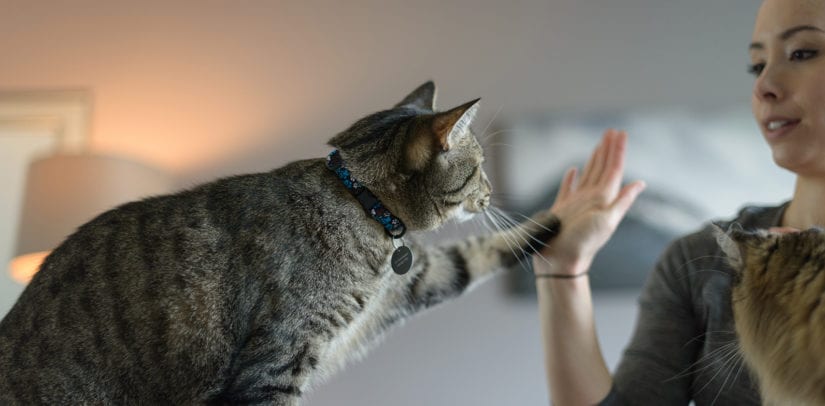
Tips to help keep your cat safe outside
Think about all the risks before deciding to let your cat go outside. It might be hard to change her habit of going out if you change your mind and want to keep her in.
- Train your cat to come back at a certain time every day by feeding her only then.
- Give your cat access to the inside of the house or a safe shelter near the house to escape other cats or dogs if one is chasing her.
- Train your cat to respond to a whistle by blowing the whistle every time you feed her or give her a treat. (Be careful as your cat may come running from across the street when she hears the whistle. You should not use the whistle unless you know it is safe).
- Talk to your vet about vaccines and parasite prevention.

Read more about indoor vs outdoor cats and how to enrich your cat’s life
Indoor versus outdoor – how to provide the best environment for your cat (PDF)
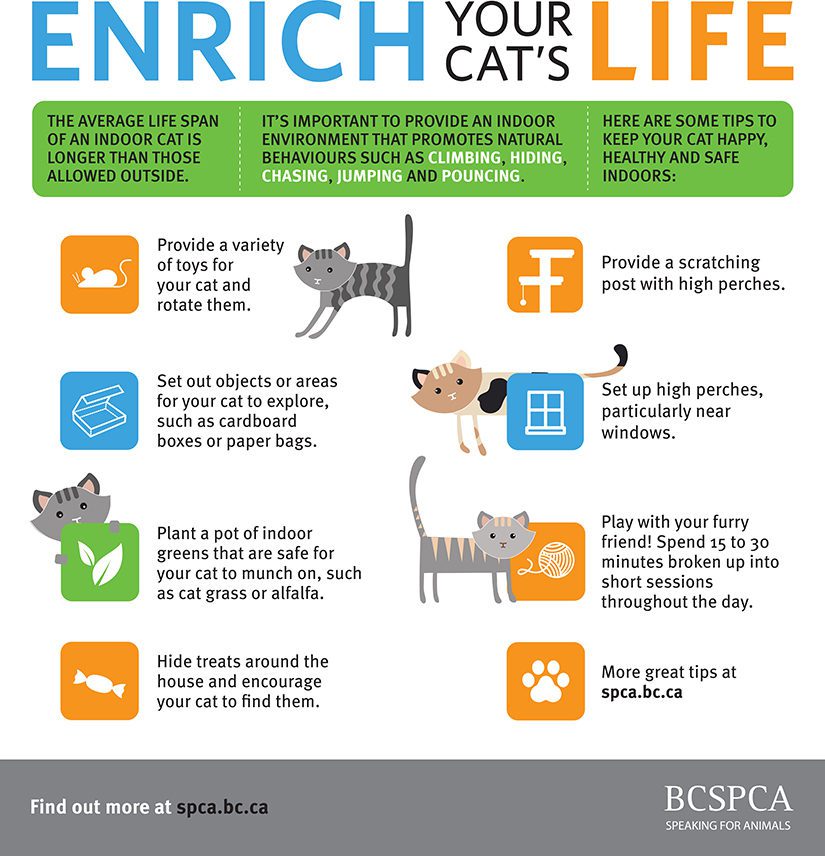
Most antifreeze is made from ethylene glycol. Ethylene glycol-based antifreeze tastes sweet but is highly toxic to both humans and animals. To help protect pets, wildlife and children, the provincial government passed a regulation that requires the addition of a bittering agent to all antifreeze sold at the consumer level in British Columbia. The regulation, the first of its kind in Canada, took effect in 2011.
While a bittering agent may make antifreeze less appealing, ethylene glycol is still harmful, even in small amounts. Consumers should be encouraged to use antifreeze made from propylene glycol instead. Propylene glycol-based antifreeze is slightly more expensive, but is considered non-toxic to pets and wildlife.
Antifreeze facts
- Antifreeze is the brightly coloured liquid that is poured into radiators and circulates through engines to keep them operating at safe temperatures.
- All cars, trucks, buses and farm tractors use antifreeze to help prevent their engines from freezing over in the winter and overheating in the summer.
- Conventional antifreeze contains ethylene glycol, which is very poisonous to people and animals.
- Even in the smallest amounts, antifreeze can have a very harmful and often fatal effect on your pet. A single teaspoon will kill a cat and a few tablespoons are enough to kill a medium-sized dog.
- Antifreeze leaks from automobiles and is spilled in garages and onto pavement due to careless fluid changes.
- In some instances, antifreeze has been used to deliberately poison animals as an act of cruelty.

What do I do if my pet consumes antifreeze?
Animals who have ingested antifreeze go through two stages of symptoms. If untreated, death from kidney failure will occur within days.
If you suspect your animal has ingested antifreeze, seek veterinary aid immediately. YOUR PET WILL NOT RECOVER ON THEIR OWN. Time is critical as within minutes your pet will begin to experience kidney damage. Learn what to do if your pet has consumed antifreeze.

Use animal-friendly antifreeze
Fortunately, there is a less toxic alternative to the ethylene glycol-based antifreeze that is most commonly used. Animal-friendly antifreeze contains propylene glycol and is anti-corrosive, biodegradable and recyclable. This makes it a better choice for the safety of pets and wildlife, personal health, vehicle engine protection and the environment. It may cost a few dollars more but it could save lives. Make the switch today!
Customers can request pet-friendly propylene glycol antifreeze from their automotive service centre or purchase it separately and ask that their auto centre to install the product.
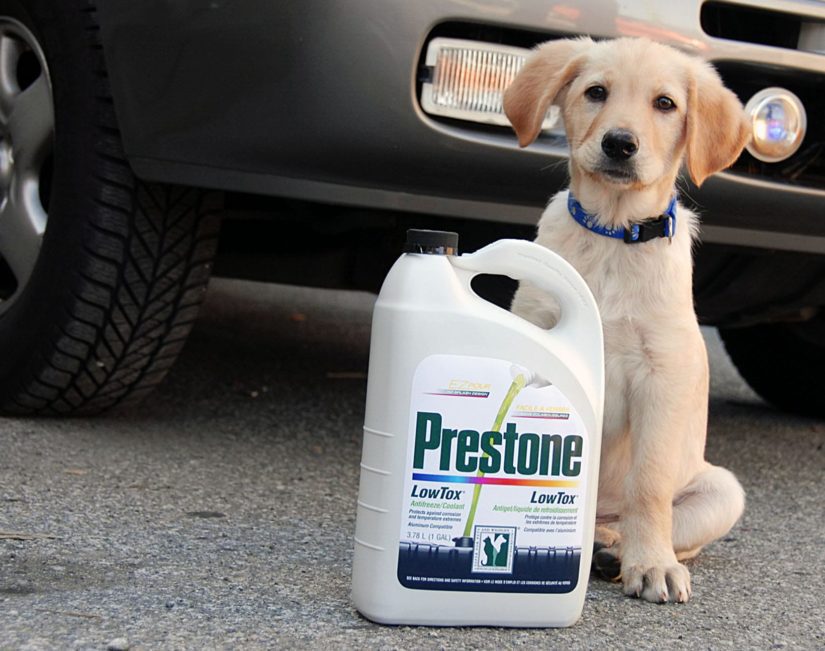
What can I do to help?
- Download our poster today and help spread the word! (PDF)
- Mop up spills and dispose of antifreeze properly.
- Take used ethylene glycol or propylene glycol antifreeze to an auto centre that recycles antifreeze.
- Never pour any used antifreeze (ethylene glycol or propylene glycol) down storm drains, sinks, toilets or on the ground. B.C. has a network of collection facilities that accept used antifreeze (ethylene glycol and propylene glycol), oil, oil filters and oil and antifreeze containers at no charge. Visit the B.C. Used Oil Management Association website to find a location near you or contact the Recycling Council of B.C. at 1-800-667-4321 for a list of outlets.
- Find out more about cold weather pet safety and how to keep your furry family members safe during cold weather.
What is toxoplasmosis?
Toxoplasmosis is an infection caused by a tiny parasite, Toxoplasma gondii. It can infect both cats and people, but most healthy animals and people won’t get sick because their immune systems will protect them.
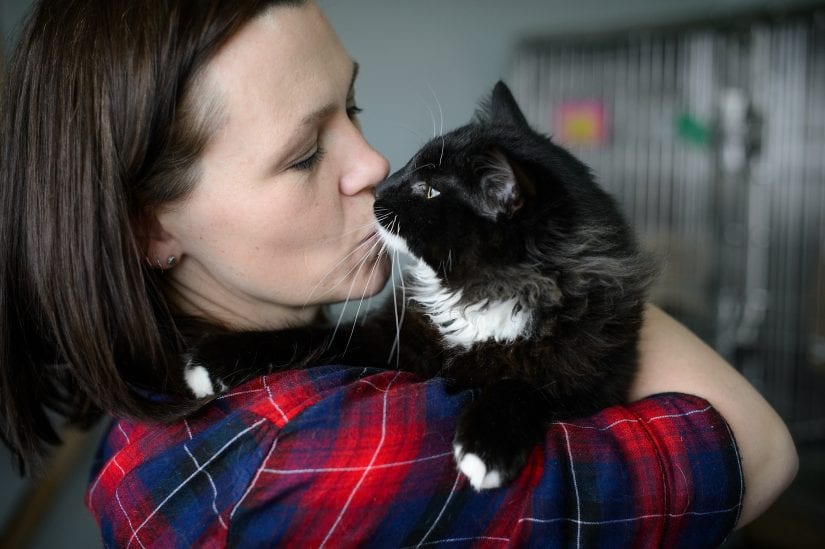
How toxoplasmosis is transmitted to humans
Most people who get toxoplasmosis get it from eating undercooked meat or unwashed produce. Because cats only shed the parasite for the first few days after becoming infected, infection from cats is rare.
- Handling and/or eating raw or undercooked food
- Handling and/or eating unwashed fruits and vegetables
- Drinking unpasteurized milk
- Eating or drinking from contaminated sources
- Being exposed to cat feces from their litter box
- Being exposed to gardens or sandboxes that may have cat feces in them
Toxoplasmosis and pregnancy
Pregnant women and people with compromised immune systems are more at risk for infection. If a pregnant woman becomes infected, her baby may have health problems.
Can pregnant women be around cats?
Yes, pregnant women can be around their cats, though there are some precautions to take:
- Do not change your cat’s litter. If you have to change the cat’s litter yourself, make sure you wear gloves and thoroughly wash your hands after
- Do not interact with any unknown cats
- Keep your cat inside
- Don’t feed any raw or undercooked meat to your cat

Still concerned about your pet and your baby?
- If you have more questions or concerns about toxoplasmosis and your baby’s health, please talk to your doctor.
- If you are concerned about toxoplasmosis and your pet’s health, please talk to your veterinarian.
What is the rabies virus?
Rabies is a viral disease of warm-blooded animals that can be transmitted to humans. It is caused by a virus of the Rhabdoviridae family, which attacks the central nervous system and eventually affects the brain. Rabies is almost always fatal in animals and people once symptoms occur.
How is rabies transmitted between animals and humans?
The virus is transmitted through close contact with the saliva of infected animals, most often by a bite or scratch. It can also be transmitted by licks on broken skin or mucous membranes, such as those in the eyes, nasal cavity or mouth. In very rare cases, person-to-person transmission has occurred when saliva droplets became aerial. Bat bites can inflict small wounds and go unnoticed.
Who is at risk of being infected by rabies?
Bats are the only known wild carrier of rabies in B.C. Like cats and dogs, raccoons, coyotes, skunks, farm animals, and any other mammals are capable of contracting the rabies virus, but are not considered carriers in B.C.
In other provinces like Ontario, raccoons, coyotes, skunks and foxes are wild carriers of rabies. In B.C., however, the only carrier of rabies is bats; no raccoons or skunks in B.C. have ever transmitted rabies.
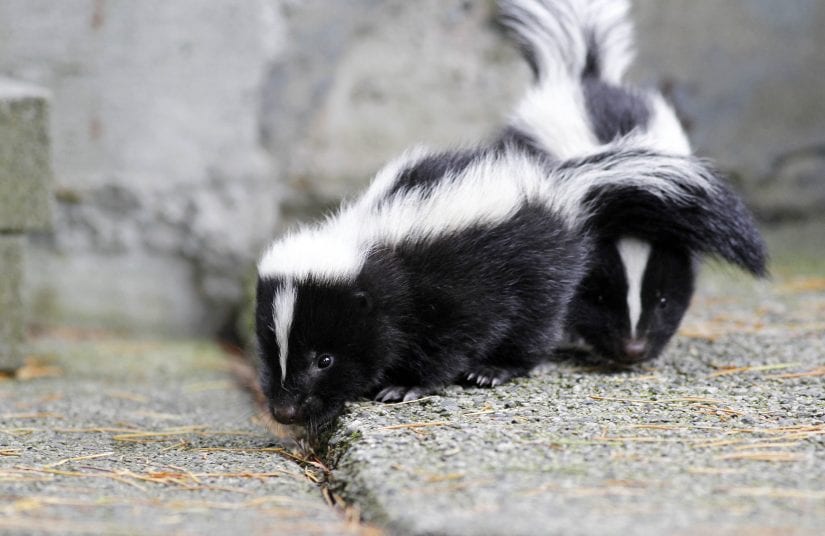
How common is rabies in bats in B.C.?
It is estimated that one per cent of bats in the wild in B.C. carry rabies. In June 2004, four skunks in Stanley Park in Vancouver tested positive for the rabies virus. However, it was discovered that they all carried the bat strain of rabies; likely they had all been in contact with a rabid bat.
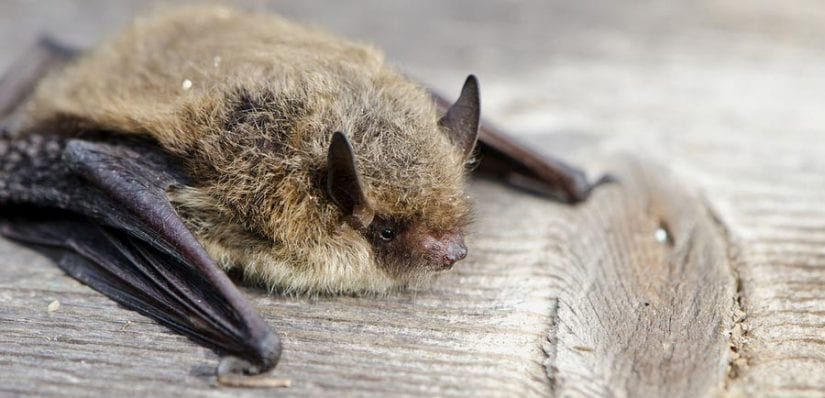
Cases of human rabies infection in Canada
In the past 25 years, five people in Canada have died of rabies infection: one in Quebec (2000), one in Alberta (2007), one in Ontario (2012) and two in British Columbia (2003 and 2019). In the Ontario case, rabies exposure occurred outside the country. These were the first cases of human rabies in Canada since 1985.
The most likely source of infection for both B.C. individuals was unrecognized bat exposure. Without wound cleansing or post-exposure vaccinations, the potential incidence of rabies in exposed humans can be very high.
Does my pet need a rabies vaccine?
Dogs and cats account for fewer than five per cent of all animal rabies cases in Canada. However, rabies presents a serious public health risk, and even indoor pets could come in contact with a bat. Some pets also need the vaccine for travel. Ask your vet whether your pet should be vaccinated.
What if my pet brings a bat home?
If your pet brings home a bat, you should take your pet to a veterinarian. If the bat is available, your vet may send it for rabies testing. Additionally, your vet may vaccinate your pet against rabies and/or ask you to keep your pet in your home for several months to see if they develop signs of rabies.
If any person in your household has touched a bat with bare skin, seek medical attention from a doctor or local public health unit immediately.
What will happen to the bat?
The bat may be euthanized and sent for testing. As of April 1, 2014, CFIA veterinary inspectors are no longer involved in species collection activities. However, the CFIA continues to perform and cover the cost for rabies laboratory testing involving domestic and wild animals and humans. This is vital as once the symptoms of rabies (flu-like including fever, headache and fatigue, progressing to gastrointestinal and central nervous system problems) start to appear, there is no treatment and the disease is almost always fatal. However, wound cleansing and immunizations, done as soon as possible after suspected contact with an animal, can prevent the onset of rabies in virtually 100 per cent of exposures.
What to do if there has been contact with a bat
Bat-to-person contact?
If treatment is given promptly after being exposed to (any bare skin contact) or bitten by a bat, the illness may be prevented by taking the following actions:
- Immediately wash the wound or exposed surface with soap and water for 10 minutes and cover the area with a clean bandage.
- Remove any clothing that may have been contaminated.
- Immediately call your doctor and local health authority for advice.
Bat-to-pet contact?
Please contact your veterinarian to have your pet vaccinated and discuss whether a period of isolation/observation is required for your pet. If the bat is available, your veterinarian may send it for rabies testing.
Found an injured bat?
No matter how injured, a bat should never be touched with bare hands. Please refrain from nudging or picking the bat up.
Injured bats can be rehabilitated by professionals able to take the necessary precautions against rabies transmission. Call the BC SPCA Animal Helpline at 1-855-622-7722 for advice on safely containing bats and finding a wildlife rehabilitator.
Allowing a female cat or dog to produce a litter does not have any benefits to the animal. Animals who go through heat cycles and pregnancy are at higher risk for uterine and mammary problems, including mammary cancer, which can be fatal.
There are health risks to the mother during the pregnancy and when giving birth. Proper pre-natal care, emergency care for birth complications, and proper newborn care are expensive and time-consuming.
Learn more about the benefits of spaying and neutering your pet.

Most unintentional litters (particularly with cats) occur because guardians waited too long to have the surgery done. The usual recommendation is before six months of age for cats, and before six and a half months for dogs. Consult your veterinarian to determine the best time for your pet. Female cats and dogs do not have to have a litter before being fixed.
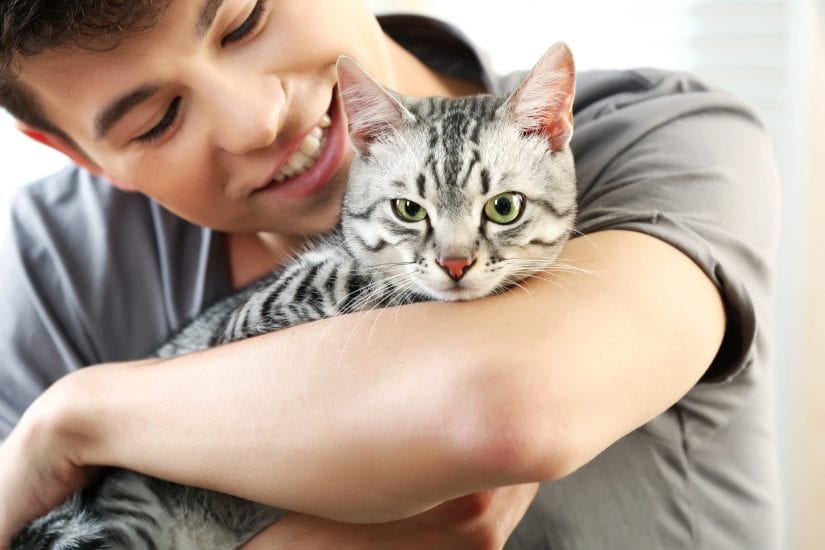
The BC SPCA supports early age spay/neuter procedures for dogs and cats. Pediatric sterilization prevents excess litters by ensuring animals are sterilized before adoption. This helps combat pet overpopulation and euthanasia of unwanted animals. All major professional, academic, and animal welfare organizations in North America support pediatric spay/neuter for shelter animals.
The BC SPCA will continue to promote other methods of combating pet overpopulation, including education and public awareness campaigns, non-surgical methods of sterilization, traditional spay/neuter initiatives and behaviour training.
The BC SPCA believes pediatric spay/neuter to be appropriate with the following qualifications:
- The procedure takes place between 8 and 16 weeks of age
- The animal is judged to be clinically normal and healthy prior to surgery
- Proper surgical protocols specific to these young animals are employed
- Post-surgery complications receive special attention
No. Your pet will actually benefit from spaying or neutering, because he or she will lead a healthier and longer life. Pets become fat and lazy as a result of overeating and a lack of exercise, not from spaying or neutering. Furthermore, spaying a female eliminates the possibility of her developing uterine and/or ovarian cancer and greatly reduces the chance of breast cancer. Neutering a male eliminates the risk of testicular cancer.

